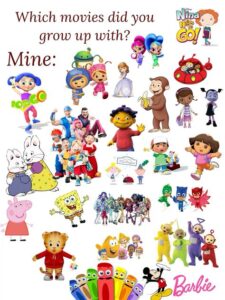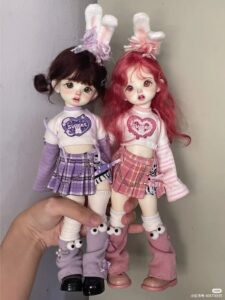Uncategorized
The Evolution of Kids’ Accessories Through the Decades
Kids’ fashion has always been influenced by broader societal trends, and accessories are no exception. From practical additions to whimsical embellishments, kids’ accessories have evolved dramatically through the decades, reflecting shifts in culture, technology, and consumer priorities. These small but impactful pieces offer insight into how children’s styles have changed while maintaining their playful and functional essence.
Let’s take a nostalgic journey through the decades to explore how kids’ accessories have evolved, decade by decade.
1920s: Classic and Practical
The 1920s marked a time when kids’ accessories leaned heavily on functionality rather than style.
- Hats: Boys often wore flat caps or fedoras, while girls sported cloche hats, mirroring adult trends.
- Shoes: Sturdy leather lace-up boots or Mary Janes were standard, paired with knitted socks.
- School Bags: Simple satchels or knapsacks carried school essentials.
- Hair Accessories: Girls used ribbons and bows to tie their hair neatly.
The focus on practicality was driven by economic constraints and the influence of adult styles.
1930s: Modesty and Utility
The Great Depression influenced kids’ fashion in the 1930s, with accessories prioritizing durability and affordability.
- Sun Hats: Wide-brimmed hats became popular for protecting kids from the sun during outdoor chores or play.
- Handkerchiefs: Personalized handkerchiefs with embroidered initials were both practical and decorative.
- Suspenders and Belts: These were essential for boys’ outfits, adding both function and formality.
- Scarves: Simple knitted scarves kept kids warm during colder months.
Accessories of this era reflected the resourcefulness and simplicity necessitated by economic hardships.
1940s: War-Time Influences
World War II brought a focus on utility and practicality, even in kids’ accessories.
- Utility Bags: Kids carried small gas mask cases in certain regions, often doubling as school bags.
- Hair Accessories: Girls used fabric scraps or bandanas to tie back their hair, inspired by Rosie the Riveter-style practicality.
- Knitted Hats and Gloves: Hand-knitted accessories became a norm due to fabric rationing.
- Functional Footwear: Leather shoes with durable soles were common, reflecting the need for longevity.
The wartime emphasis on frugality and practicality was evident in every aspect of children’s accessories.
1950s: Post-War Prosperity and Playfulness

The 1950s ushered in an era of economic recovery and optimism, reflected in the colorful and playful accessories for kids.
- Hair Bows and Headbands: Girls wore bright, oversized bows or headbands, often matching their dresses.
- Gloves: Formal occasions saw children donning white or pastel gloves, emulating adult fashion.
- School Accessories: Lunch boxes with popular characters, such as Disney designs, became a staple.
- Sunglasses: Cat-eye or round sunglasses for kids mirrored the glamorous styles of Hollywood.
This decade marked the beginning of accessories as fun, expressive elements in kids’ wardrobes.
1960s: Bold and Trendy
The 1960s introduced bold colors and mod-inspired designs in kids’ accessories, influenced by cultural revolutions.
- Go-Go Boots: Miniature versions of the iconic adult boots became a fashionable choice for girls.
- Colorful Tights: Brightly colored or patterned tights became a playful addition to dresses.
- Hair Accessories: Beaded headbands and barrettes gained popularity, adding pops of color to hairstyles.
- Backpacks: Simple yet colorful backpacks started replacing satchels, reflecting the rise of casual school styles.
Kids’ accessories in the 1960s embraced the era’s experimental and vibrant aesthetic.
1970s: Bohemian and DIY Trends
The 1970s embraced the bohemian, nature-inspired vibes of the era, with kids’ accessories reflecting the DIY spirit.
- Flower Crowns: Inspired by the hippie movement, flower crowns were a favorite for girls during outdoor play or festivals.
- Friendship Bracelets: Handwoven bracelets symbolized friendship and creativity.
- Leather Accessories: Belts, sandals, and small pouches made from leather added a rustic touch to kids’ outfits.
- Hats: Wide-brimmed straw hats and floppy fabric hats were common for both style and sun protection.
This decade celebrated individuality and self-expression through simple, handmade accessories.
1980s: Big, Bold, and Branded
The 1980s brought an explosion of color, logos, and bold statements in kids’ fashion accessories.
- Scrunchies and Hair Clips: Neon-colored scrunchies and oversized plastic hair clips were a must-have for girls.
- Logo Bags: Branded backpacks and fanny packs featuring cartoon characters like Mickey Mouse and Garfield became staples.
- Jewelry: Plastic bangles and charm necklaces added a playful touch to outfits.
- Athletic Accessories: Sweatbands, tube socks, and branded sneakers reflected the fitness craze of the decade.
Kids’ accessories in the 1980s were as loud and vibrant as the culture itself.
1990s: Minimalism Meets Pop Culture
The 1990s blended minimalist trends with a heavy influence from pop culture and technology.
- Chokers: Stretchy plastic chokers were trendy among older kids and tweens.
- Character-Themed Items: Backpacks, lunch boxes, and caps featuring characters like Power Rangers and Pokémon dominated.
- Bucket Hats: Popularized by the hip-hop scene, bucket hats became a trendy yet functional accessory.
- Tech Accessories: Tamagotchis and keychain toys often dangled from backpacks, becoming accessories in their own right.
This decade highlighted the growing influence of media and pop culture on kids’ accessories.
2000s: Functional Meets Fashionable
The new millennium saw a mix of practicality and style, with kids’ accessories becoming more personalized.
- Velcro Wallets: Brightly colored wallets with cartoon designs were a popular way for kids to carry pocket money.
- Messenger Bags: These became a stylish alternative to traditional backpacks.
- Bedazzled Hair Clips: Glittery and rhinestone-studded clips were all the rage.
- Sports-Inspired Accessories: Baseball caps, wristbands, and branded sneakers reflected the era’s sporty trends.
Kids’ accessories in the 2000s offered a balance of functionality and self-expression.
2010s: Personalization and Sustainability

The 2010s brought a focus on customization and eco-friendly trends in kids’ accessories.
- Monogrammed Items: Personalized backpacks, lunch bags, and water bottles became increasingly popular.
- Sustainable Choices: Reusable lunch containers, water bottles, and eco-friendly bags reflected the growing environmental consciousness.
- Tech Accessories: Cases for tablets, phones, and smartwatches became essential items for older kids.
- Stylish Footwear: Light-up sneakers and glittery boots added a playful yet modern flair.
This decade saw accessories becoming a blend of individuality and practicality.
2020s: Functionality and Inclusivity
Modern kids’ accessories focus on functionality, inclusivity, and a touch of tech-savviness.
- Gender-Neutral Designs: Accessories like backpacks and hats are designed to suit all kids, breaking traditional gender norms.
- Sustainable Fabrics: Organic cotton hats, biodegradable sunglasses, and recycled plastic bags are now mainstream.
- Smart Features: Tech-integrated items like GPS-enabled watches and backpacks with charging ports reflect the digital age.
- Whimsical Elements: Accessories with unicorns, rainbows, and glitter continue to delight younger kids.
Today’s kids’ accessories cater to both practical needs and imaginative play, offering a versatile range of options.
Conclusion
The evolution of kids’ accessories reflects changing cultural, technological, and social trends over the decades. From the practical hats of the 1920s to the tech-savvy gear of the 2020s, these items have consistently combined functionality with style. As we look to the future, kids’ accessories will likely continue to prioritize sustainability, individuality, and innovation, ensuring that children can express themselves while staying practical.
At Regal XX Hue, we celebrate this rich history by offering a curated collection of timeless and modern kids’ accessories that reflect both tradition and innovation. Explore our range today to find the perfect touch for your child’s wardrobe!


